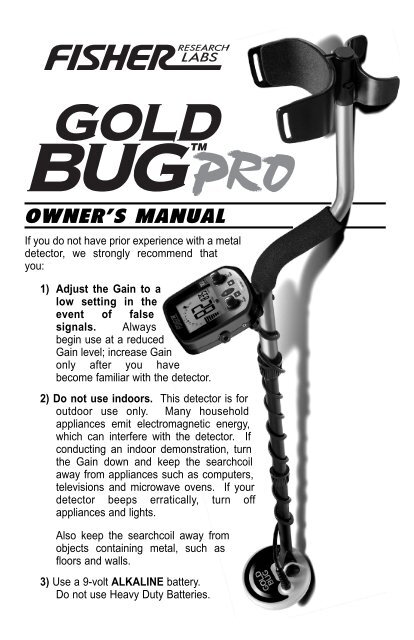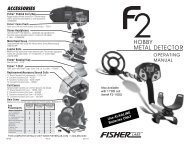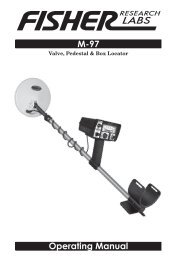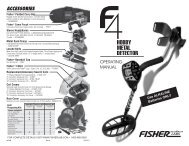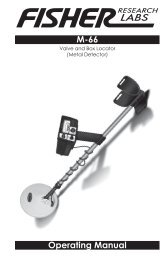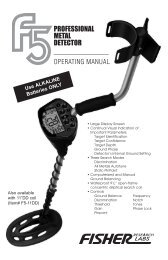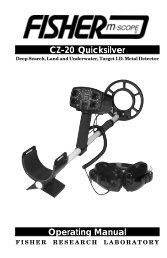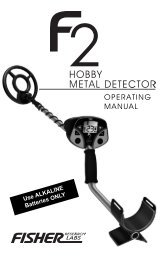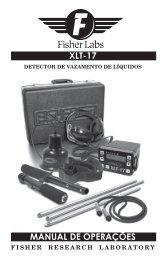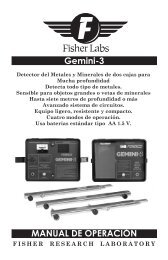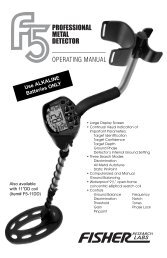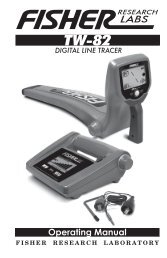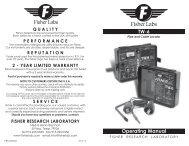Gold Bug Pro Manual - Fisher
Gold Bug Pro Manual - Fisher
Gold Bug Pro Manual - Fisher
Create successful ePaper yourself
Turn your PDF publications into a flip-book with our unique Google optimized e-Paper software.
Congratulations!Congratulations on your purchase of the new <strong>Gold</strong> <strong>Bug</strong> <strong>Pro</strong> metal detector. The newlydesigned <strong>Gold</strong> <strong>Bug</strong> <strong>Pro</strong> has been custom designed to find the smallest gold nuggets,but unlike other specialized gold prospecting detectors, it can also be used for relichuntingand coin-shooting.Whether you use your Detector in the backyard, at the shoreline, in the mountains orfields afar, your investment will let you experience the excitement of searching for yetuncovered treasures and give you hours and years of outdoor enjoyment. Out on yourown or with a group, places to use your <strong>Gold</strong> <strong>Bug</strong> <strong>Pro</strong> are unlimited as buriedtreasures can be as near as your doorstep or as far as you wish to travel.This manual has been written to help you get optimal use of your detector, so we hope youwill read it thoroughly before your first outing and will also refer back to this manual fromtime to time to reinforce features and methods as you become more proficient in the field.Happy Hunting from <strong>Fisher</strong> Research Labs!Introduction to the <strong>Gold</strong> <strong>Bug</strong><strong>Pro</strong>The new <strong>Gold</strong> <strong>Bug</strong> <strong>Pro</strong> is unique among gold prospecting metal detectors forits combination of high sensitivity to small gold nuggets and its versatilefunction as an all-purpose treasure detector.The controls and features are tailored to gold prospecting, including asophisticated ground balancing system, separate control over signal gain andthreshold, and a unique discrimination control system. These features alsomake for a great relic-hunting detector, especially when the <strong>Gold</strong> <strong>Bug</strong> <strong>Pro</strong> isoutfitted with the optional 11” DD searchcoil. While the <strong>Gold</strong> <strong>Bug</strong> <strong>Pro</strong> makesfor a highly competent coin-shooting detector, its user interface and featuresare not specifically designed for this purpose. As a coin-shooter, you willnotice that the <strong>Gold</strong> <strong>Bug</strong> <strong>Pro</strong> exhibits slightly lower sensitivity to highconductivitycoins, like a U.S. quarter; this is a result of its specialized designto emphasize sensitivity to small, low conductivity metals like gold nuggets.The <strong>Gold</strong> <strong>Bug</strong> <strong>Pro</strong> is outfitted with a small 5” searchcoil as standardequipment since this searchcoil construction is best-suited to finding goldnuggets. You may be familiar with other metal detectors which have largersearchcoils, generally in the range of 8 to 10 inches in diameter. Large coilsare designed to cover the maximum amount of ground efficiently and for thedeepest ground penetration. Small searchcoils, intended for gold prospecting,are designed for precision. The <strong>Gold</strong> <strong>Bug</strong> <strong>Pro</strong>’s small DD searchcoil makespinpointing easier, fits into small spaces where gold is often hidden, is bettersuited to penetrate highly mineralized soils where gold is frequently found, andhas the highest possible sensitivity to tiny gold nuggets.4
BATTERIESA 3-segment battery indicator at the bottom of the display indicates thebattery condition.The detector requires a single 9-volt ALKALINE battery.Do not use ordinary zinc carbon batteries.Do not use “Heavy Duty” batteries.Rechargeable batteries can also be used.If you wish to use rechargeable batteries, we recommend using aNickel Metal Hydride rechargeable battery.The battery compartment is located on the back side of the housing.Slide the battery door to the side and remove it to expose the batterycompartment.BATTERY LIFEExpect about 15 to 20 hours of life from a 9-volt alkaline battery.Rechargeable batteries can provide up to 8 hours of usage per charge.SPEAKER VOLUME AND BATTERY CHARGEYou may notice the speaker volume drop when only one battery segment isilluminated.With one segment flashing, low speaker volume will be very apparent.BATTERY INDICATORThe 3-segment battery indicator has 4 stages of indication.These indications are accurate for a 9-volt alkaline battery.8Segments Illuminated Battery Voltage3 -segments more than 8.4 volts2 -segments more than 7.5 volts1 -segment more than 6.8 volts1 -segment flashing less than 6.8 voltsAfter the 1st segment begins flashing, expect the detector to shut off within 10minutes.A rechargeable battery will usually illuminate two to three segmentsthroughout most of its useful charge. But as soon as it drains to the 1-segmentlevel, it will then lose its charge very rapidly.
QUICK-START DEMONSTRATIONI. Supplies Needed• a Nail • a Zinc Penny (dated after 1982)• a Nickel • a QuarterII.III.IV.Position the Detectora. Place the detector on a table,with the searchcoil hanging overthe edge.Or better, have a friend hold thedetector, with the searchcoil offthe ground.b. Keep the searchcoil away fromwalls, floors and metal objects.c. Remove watches, rings andjewelry.d. Turn off lights or appliances,whose electromagnetic emissions may cause interference.e. Pivot the searchcoil back.Click on detector with the left knob. Set the Gain at the12:00 position for this demonstration.Click the right knob to the left to the DISC setting.V. a. Wave the nail over the searchcoil.b. Press + repeatedly, while continuing to wave the nail.• Notice the change in sound.• Sound changes from a HIGH tone to V.C.O. tones (seepage 25).VI. Wave each object over the searchcoil.Sweep coin flat and parallel to the searchcoil. This is howyou will usually find them buried.a. Notice the tones and 2-digit target IDs for each object.b. Motion is required.Objects must be in motion over the searchcoil to bedetected in this mode.VII. Press the + button several more times until the Disc value on thedisplay = 60.VIII. Wave the nail over the searchcoil.a. The nail will not be detectedb. The nail has been “discriminated out.”Quick-Start Demo continued on next page9
QUICK-START DEMONSTRATIONIX. Press-and-hold and hold the nickel over the searchcoila. Notice that motion is not required.A motionless object induces a hum.b. Notice the variable pitch & volume hum.c. Move the nickel closer to and farther away from the searchcoil.Notice the changing “depth” values.X. Click the MODE knob to the right.The detector is now in the ALL-METAL Modea. Keep GAIN set at the 12:00 positionb. Rotate the THRESHOLD knob slowly from the far counterclockwiseposition to the full clockwise position.Notice these attributes of the THRESHOLD control, with no metalover the searchcoil.i. at low settings you will hear no soundii. at mid-scale, there will be a transition point from no sound toa barely audible, choppy sound.iii. at full scale you will hear a loud, constant tone. It may also havean irregular or choppy sound, as a result of electromagneticinterference emitted from other electrical devices.Use with headphones (not included)10The <strong>Gold</strong> <strong>Bug</strong> <strong>Pro</strong> is equipped with both a 1/8” and 1/4” headphone jack. Anyheadphones with a stereo plug will work; headphones with a mono plug will notwork. Using headphones extends battery life, and also prevents the sounds frombothering bystanders. It also allows you to hear subtle changes in the sound moreclearly, particularly if searching in a noisy location. <strong>Gold</strong> nuggets are often verysmall, so closely monitoring changes in sound using headphones will improve yourgold prospecting results. For safety reasons, do not use headphones near trafficor where other dangers, like rattlesnakes, are present. This device is to be usedwith interconnecting cables/headphone cables shorter than three meters.
THE BASICS OF METAL DETECTINGA hobby metal detector is intended for locating buried metal objects. Whensearching for metals, underground or on the surface, you have the followingchallenges and objectives:1. Ignoring signals caused by ground minerals.2. Ignoring signals caused by metal objects that you do not want to find,like pull-tabs.3. Identifying a buried metal object before you dig it up.4. Estimating the size and depth of objects to facilitate digging them up.5. Eliminating the effects of electromagnetic interference from otherelectronic devices.Your <strong>Gold</strong> <strong>Bug</strong> <strong>Pro</strong> metal detector is designed with these things in mind.1. Ground MineralsAll soils contain minerals. Signals from ground minerals can interfere withthe signals from metal objects you want to find. All soils differ, and candiffer greatly, in the type and amount of ground minerals present. Youtherefore want to calibrate the detector to the specific ground conditionswhere you are hunting. The detector incorporates both automated andmanual ground balancing features which will eliminate false signals frommost types of soils. To maximize the detector’s target identificationaccuracy and depth of detection, use the GROUND GRAB (GG) functionto calibrate the detector to the ground where you are searching. See thesection on GROUND BALANCING for details.The Basics continued on next page11
CONTROL PANELCONTROL KNOBS:1. OFF/ON/GAINa. Click right to turn on. Click left to turn off.b. Turning the knob clockwise increases the detector’s sensitivity; thehigher the sensitivity, the deeper targets will be detected, and the morelikely the detector will be to detect very small targets.c. As you turn the knob, notice that the GAIN value at the bottom-right ofthe screen displays your current sensitivity setting.Sensitivity in DISC modeThe left knob is labeled “GAIN” and in DISCRIMINATION mode it alonecontrols the sensitivity of the detector.GAIN in ALL-METAL mode.In All-Metal mode, GAIN increases as you rotate the knob clockwise.THRESHOLD is controlled independently using the right knob.2. DISC / ALL-METAL / THRESHOLDa. Click knob to the far-left “DISC” position and the detector entersDISCRIMINATION mode.b. Click on clockwise to operate in ALL-METAL mode.c. In ALL-METAL mode, rotate knob to increase the threshold.Threshold values range from -40 to +40.In ALL-METAL mode, the Threshold control can be used in two ways.14Control knobs continued on next page
CONTROL PANELGAIN versus THRESHOLD“Gain” increases, or multiplies, the strength of signals from buried metal objects.For maximum detection of the smallest or most deeply buried objects, increasethe Gain. To minimize the weakest signals, reduce the Gain.“Threshold” controls the detector’s audio level. Positive threshold valuesamplify the audio response of weak target signals. Negative thresholdvalues suppress sensitivity.For searching at maximum sensitivity, first set the gain at a low level. Thenset threshold into the positive region, with a comfortable background-humvolume level. Then increase Gain to a comfortable level, free of chatter.For silent searching, set threshold to a negative number, and also reduceGain if necessary. Silent searching will result in the loss of some sensitivity.TOUCHPAD CONTROLS1. GG / PINPOINTThis button has a dual function, depending on the detection mode.a. In DISC mode, press-and-hold the button to activate PINPOINT.Pinpoint temporarily engages a no-motion detection mode. Searchcoilmotion is not necessary to detect metal. Any metal within the searchcoil’sdetection field will induce a sound. Pinpoint is generally used to verify atarget previously detected in Discrimination mode.b. In ALL-METAL mode, press-and-hold the button to activate GROUND GRAB.Ground Grab allows you to set the detector’s internal ground setting equalto the phase of the ground you are searching over. See the section onGround Balancing for a more thorough explanation of this feature and thereason for using it.2. + and -a. In Discrimination mode, + and - change the level of discrimination (targetrejection)b. In All-Metal mode, + and - provide a manual override to the Ground BalanceSetting.15
OPERATING IN ALL-METAL MODEThe All-Metal mode is more sensitive than the Discrimination mode, and is used tofind all types of metal objects in the ground. The searchcoil must be in motion forobjects to be detected.Ground Grab (GG)Naturally occurring minerals in soil look like metal to a metal detector, so you want tocancel out this mineral signal coming from the ground, and only detect the signal frommetal objects in the ground.So before using your detector, set it in All-Metal mode and perform the automaticground balancing procedure. Press-and-hold the GG button while pumping thesearchcoil up and down over the ground. Release the button when the sound evensout. The GND BAL number on the bottom right of the screen is the detector’s internalsetting which cancels out the minerals in the ground. Different soils in different areaswill require different GND BAL settings, so balance to ground before you search.Refer to the Ground Balancing section of this manual for a more in-depth explanation.Setting the ControlsAs you adjust any of the controls, notice that the values on the bottom-right of thedisplay indicate the settings of the value you are changing.If you are new to metal detecting, start with the GAIN and THRESHOLD controls at alow enough setting that you do not hear too many unwanted sounds, like warble or aloud hum. Set the GAIN at the 12:00 position, or less. Then set the THRESHOLD to aposition where you hear a very slight background hum, or if you prefer, dial the controljust left of that position to a setting where the detector is silent.Unwanted NoiseRead the section on Electromagnetic Interference.The <strong>Gold</strong> <strong>Bug</strong> <strong>Pro</strong> is a highly sensitive device.It is intended for use outdoors. Indoor operation will subject it to interference from awide variety of devices in the home or office.Sweeping the SearchcoilAs you sweep the searchcoil over the ground, try to keep the searchcoil parallel to theground.Avoid lifting the searchcoil at the end of your sweeps.16Operating in All-Metal Mode continued on next page
OPERATING IN ALL-METAL MODEReading the DisplayMost gold prospecting and relic hunting is done by ear. Listen for the louder sounds,riding on top of the constant background hum.As you sweep the searchcoil, notice the Fe 3 O 4 (iron oxide) scale to the left of thedisplay.This indicates the amount of ground mineralization.Most black sand is made of magnetite.<strong>Gold</strong> nuggets are often found in concentrated black sand deposits.For the best depth detection in highly mineralized soils, use the All-Metal mode.For the most accurate Fe 3 O 4 reading, pump the searchcoil over the ground.While sweeping the searchcoil, also notice the GND PHASE value in the middle of thescreen.GND PHASE is the ground phase; this indicates the type of minerals in the soil.Within an area, the ground phase may change.After ground balancing, periodically compare GND PHASE to GND BAL. If these twonumbers differ by a great deal, you may want to ground balance the detector again.When not adjusting the knobs, the GND BAL setting will always appear on thebottom-right of the display.GND BAL is the detector’s internal ground balance setting. The detector’s defaultground balance setting is 82.9, which is the best starting point for achieving thecorrect setting.After you perform the Ground Grab procedure, the GND BAL number will changeto match your soil.You can change the current GND BAL setting by pressing the + or – buttons.See section on Ground Balancing for a more detailed explanation.Experienced users often prefer to adjust the ground balance to get a weakaudible response when lowering the searchcoil to the ground. This is calledadjusting for positive response and is achieved by increasing the GND BALnumber with the + key.Target ScaleThe arc across the top classifies metal objects.Each time a target is detected, three segments will illuminate above the arc.The segments will remain illuminated for three seconds.This indication shows the approximate classification of the buried metal object.See the section on Target Display for a more detailed explanation.Iron is on the left. U.S. dimes and quarters are to the far right.In an air test, gold indicates right of center -- the larger the gold piece, thefarther to the right.In the ground, the I.D. of gold may jump around with each pass of the searchcoil.If searching in All-Metal mode, you may want to switch back into Discrimination mode, afterfinding a target, to see a more accurate target identification, viewing the 2-digit Target I.D.17
OPERATING IN DISCRIMINATION MODEDiscrimination is used to eliminate trash metal objects (e.g. nails, foil, pull-tabs) fromdetection. The searchcoil must be in motion to detect metal. The Discrimination modeis less sensitive to small and deep objects than the All-Metal mode.Ground Grab (GG)This feature is not available in Discrimination mode.Your best results will be achieved by first performing the GG procedure in All-Metal mode.The ground balance setting achieved using GG will carry over into this mode.Setting the ControlsAs you adjust any of the controls, notice that the values on the bottom-right of thedisplay indicate the settings of the value you are changing.GAINIf you are new to metal detecting, start with the GAIN at a low enough setting that you do nothear any sounds when the searchcoil is sweeping across the ground, with no metal present.Start with GAIN at the 12:00 position, or less.In this mode, Gain refers to the detector’s sensitivity. The higher the setting, the deeperobjects can be found, and the more sensitive the detector is to very small metal objects.MODEThe right knob is not used in the Discrimination mode.Click the right knob 100% counterclockwise.If you turn the knob to the right, you will leave Discrimination mode, entering All-Metal mode.DISC LEVELPress + to eliminate unwanted metals from detection.Each time you press + the Disc Value at the bottom-right of the display will increment by one.Press-and-hold + to increase the Discrimination level rapidly.See the Target Identification section of the manual for a detailed description of this function.Sections of the arc with no indication represent metals completely eliminated from detection.Sections of the arc with a lightly shaded indication represent metals detected witha low tone.Press – to detect metals which were previously eliminated from detectionUnwanted NoiseRead the section on Electromagnetic Interference.This is a highly sensitive device.It is intended for use outdoors. Indoor operation will subject it to electrical interferencefrom a wide variety of devices in the home or office.In Discrimination mode, when you sweep the coil over the ground it will usually be quieterthan when holding the detector still.Sweeping the SearchcoilAs you sweep the searchcoil over the ground, try to keep the coil parallel to the ground.Avoid lifting the searchcoil at the end of your sweeps.18Operating in Discrimination Mode continued on next page
OPERATING IN DISCRIMINATION MODEUsing PINPOINTPress-and-Hold the Pinpoint button to narrow down the location of a buried metal object.Pinpoint is a mode of detection which does not require the searchcoil to be in motion.A motionless searchcoil held over a metal object will induce a hum; volume andpitch of the hum increase with target strength.The approximate target depth, in inches, will be indicated in the center of the screen.The depth scale is calibrated to coin-sized objects.Relative depth is indicated for larger or smaller objects.Upon releasing the button, you will return to the motion Discrimination detection mode.If you keep the Pinpoint button depressed for a long time, the audio tone may begin to drift.If you plan to search like this, release and re-press the button periodically to avoiddrift. Drift may result in a loudening sound or a reduced sensitivity with no sound.See the manual section on Target Pinpointing for how to narrow down a target’s location.This technique is indispensable as long-buried metals can look exactly like thesurrounding soil to the naked eye. If you are not adept at pinpointing, digging up asmall metal object can be very frustrating. So learn how to narrow-it-down.READING THE DISPLAYTARGET IDEach time you pass the searchcoil over a metal object, a 2-digit value will appear inthe center of the display. See the manual section on Target Identification for a betterunderstand of these values.Three segments will simultaneously appear above the arc at the top of the screen.This represents the same target identification, but displayed graphically within the scale.Target ScaleThis display works as in the All-Metal mode.The arc across the top classifies metal objects.Each time a target is detected three segments will illuminate above the arc.The segments will remain illuminated for three seconds.This indication shows the approximate classification of the buried metal object.See the section on Target Display for a more detailed explanation.Iron is on the left. U.S. dimes and quarters are to the far right.In an air test, gold indicates right of center -- the larger the gold piece, thefarther to the right.In the ground, the I.D. of gold may jump around with each pass of the coil.SIGNALEach time a target is detected, bars will illuminate on the bottom left showing thestrength of the target’s signal.If all 7 bars illuminate, the target signal is strong.This may be a large metal object.Or it may be a coin-sized metal object close to the surface.If only a few bars illuminate, the target signal is weak.This may be a deeply buried object, even a big one.Or it may be a very, very small metal object, close to the surface.The depth of a coin-sized object can be confirmed using Pinpoint.19
OPERATING IN DISCRIMINATION MODEIn Discrimination mode, pressing + or – will change two detection parameters:1. Tone Identification2. Target EliminationAs the level of discrimination changes, the target segments along the arc on thescreen will be displayed in one of three states:1. Blank (no segments displayed)2. Grey (segments displayed in a shaded color)3. Black (segments are solid black)The segments along the arc will remain illuminated in this state as you arepressing + or –.This displays your chosen target discrimination parameters.At any time during operation, you can view the discrimination settings in one oftwo ways:1. On the bottom-right of the screen the DISC value is always illuminated.a. This value is the division between the LOW tones and V.C.O. tones.b. This value is the lowest target value which will be detected with aV.C.O. tone.2. Whenever you press + or –, the arc will illuminate and show yourcurrent detection parameters.The first press of + or – will change the discriminate level by one value.When a target is detected, the rectangular segments representing the targetcategory are illuminated.20Discrimination Control continued on next page
OPERATING IN DISCRIMINATION MODENotice that the segment status along the arc, and the discrimination parametersthey represent, vary as you adjust the discrimination level with + or -.For DISC values (at bottom right-hand corner of screen) up to 40:- Operation is tone discrimination only• No targets are eliminated from detection- Target IDs less than the DISC value induce a LOW tone• Represented by shaded segmentsAt DISC value = 41:- Target elimination begins•Targets in the blank segment region are not detected.- Target IDs less than the DISC value induce a LOW tone• Represented by shaded segmentsAt DISC values over 41:- Targets in the blank segment region are not detected.- The LOW tone range of targets progressively shrinks• Represented by shaded segments- Target IDs less than the DISC value induce a LOW tone• Represented by shaded segmentsAt DISC value = 80:- Targets in the blank segment region are not detected.- All detected targets induce V.C.O. tones.• Represented by solid segments- There are no LOW tones- No targets under 80 are detected.Here is an example of one possible setting:Suggestion:Try changing thesettings, watchthe screen, andpass objects overthe searchcoil ateach setting. Itwill quicklybecome obvioushow thesecontrols work.Values from 20 to 49will induce a LOW toneValues from 50 to 100will induce V.C.O. tones (see p. 25)Values lessthan 20 willNOT BEDETECTEDThis valueand higherwill induceV.C.O. tonesThis discrimination interface for the <strong>Gold</strong> <strong>Bug</strong> <strong>Pro</strong> was designed especially for relic-hunting.Relic hunters want control over what sizes of iron are detected, and also control overwhich targets are detected with a low-tone. Target values of 40 or less are ferrous.21
GROUND BALANCINGWhat is Ground Balancing?Why do I need to Ground Balance?All soils contain minerals. Signals from ground minerals areoften tens or hundreds of times stronger than a buried metalobject. The magnetism of iron minerals, found in nearly all soils,causes one type of interfering signal. Dissolved mineral salts,found in some soils, are electrically conductive, causing anothertype of interfering signal.Ground Balancing is the process by which themetal detector cancels the unwanted signalscoming from the ground minerals while still detectingthe signals from buried metal objects. This isaccomplished by matching the detector’s groundbalance setting to the phase of the ground signal.Pumping coilto groundbalance withGG button.When the detector is calibrated to the soil, theresult will be deeper target detection, quieteroperation, and more accurate target identification.How to Ground Balance your detector:Ground Balancing procedure with the “GG” touchpad.1. Turn the detector on and set GAIN at the 12:00 position.2. Click on the right knob to the ALL-METAL mode.3. Rotate the THRESHOLD control knob to the point where you hear a slightbackground hum.4. Sweep searchcoil across the ground to find a clear patch of ground withno metal present.5. Press and hold the GG touch pad, and pump searchcoil over the cleanground. See illustration above.Pump searchcoil from within 1” of ground to 6”- 8” above ground.6. When the GND PHASE settles down to only 1 or 2 numbers in variation,release the GND GRAB button while still pumping the searchcoil. Note thatthe audio response to the ground changed and “Evened Out” when youreleased the button. Also note that the GND BAL value changed. Afterbalancing, you can hunt in ALL-METAL... or return to Disc Mode.The most accurate GND PHASE value is the value displayed when “pumping”the searchcoil over the ground in an area free of metal.22Ground Balancing continued on next page
GROUND BALANCINGUnderstanding ground conditions assists the user in setting up the machine,knowing when to readjust ground balance, and in understanding the responsesof the machine while searching.This detector displays two kinds of ground data:1. The type of mineralization (which affects where the ground phase shouldbe set). This is GND PHASE2. The amount of mineralization (the greater the amount of mineralization,the greater the loss of detection depth & ID accuracy; this loss is morepronounced in Discrimination Mode). This is Fe 3 O 4 .The goal of ground balancing is to equate the GND BAL number to thePHASE number.PHASE is the measurement of the ground.GND BAL is the detector’s internal setting which calibrates the detectorto the ground’s phase.Notice that the GND BAL number is three digits, with a decimal point.PHASE has only two digits.GND BAL is a higher resolution number, so may differ a bit from PHASEin a perfectly balanced scenario.After pumping and releasing GG, the exact measurement of the groundwill be transferred to the GND BAL setting.The two-digit PHASE number displayed on the screen indicates the type ofground mineralization.Some typical ground mineralization types are:0 – 10 Wet salt and alkali5 – 25 Metallic iron. Very few soils in this range. You are probably over metal.26–39 Very few soils in this range -- occasionally some saltwater beaches40–75 Red, yellow and brown iron-bearing clay minerals75–95 Magnetite and other black iron mineralsGround Balancing continued on next page23
GROUND BALANCINGThe goal of the Ground Balancing procedure is to eliminate the sound as thesearchcoil is being pumped over the ground. In some soils, the sound is notcompletely eliminated.After balancing to ground with GG some users may want to further adjust theground balance point manually.To manually adjust ground balance:1. Operate in ALL-METAL mode.2. Pump searchcoil up and down over the ground as in the GG procedure.3. Press + or - while pumpingIf the ground balance adjustment is incorrect, there will be a difference in thesound as the searchcoil is either moving toward or away from the ground. Itsounds like you are either pulling the sound out of the ground, or pushing thesound into the ground.•If the sound is louder as you raise the searchcoil, increase the groundbalance setting.•If the sound is louder as you lower the searchcoil, reduce the ground balancesetting.NOTE: Experienced users often prefer to adjust the ground balance to get a weakbut audible response when lowering the searchcoil. This is called adjusting forpositive response.POSITIVE AND NEGATIVE RESPONSEThe purpose of ground balancing is to adjust the metal detector to ignore groundminerals. If the setting is incorrect, ground minerals will give either a positive or anegative response, depending on which direction the adjustment is off.Positive ResponseIf the GND BAL setting is too high a number, the response of minerals will bepositive. This means that when the searchcoil is lowered to the ground inPinPoint or All Metals mode, the sound will get louder as the searchcoilapproaches the ground. The sound will grow quieter as the searchcoil is raised.What, if anything, you will hear in Discrimination mode depends on thediscrimination setting.When searching in an All Metals mode, if ground balance is properly set to cancelthe ground, and you sweep over a positive hot rock, the rock will give a “zip”sound similar to that of a metal object.Negative ResponseIf the GND BAL setting is too low a number, the response of minerals will benegative. When the searchcoil is lowered to the ground in PinPoint or All Metalmode, the machine will be silent. The machine will sound off as the searchcoil islifted away from the ground. What, if anything, you hear in Discrimination modedepends on the Discrimination setting.When searching in All Metal mode a negative hot rock will produce a “boing”sound after passing over it, making it difficult to know where it is located. It willnot have the sound and “feel” of a metal object.24
GROUND BALANCING -Technical InfoFe 3O 4BARGRAPHThe Fe 3O 47-segment bargraph indicates the amount of ground mineralization,independent of type, expressed as an equivalent volume concentration ofmagnetite (Fe 3O 4). It updates every second. It is sensitive to motion and will givethe most accurate readings if you pump the searchcoil up and down several timesover the ground. The presence of metal or “hot rocks” will cause the readings to beinaccurate. If you stop moving the searchcoil, the bargraph will go blank.INDICATION RELATIVEMINERALIZATION% Fe 3O 4SUSCEPTIBILITY7 Bars High over 1 over 25002 to 6 Bars Medium .026 - 1.0 61 - 2,5001 Bar Very Low 0.006 - .025 15 - 60none -- less than .006 less than 15Magnetic susceptibility is expressed in micro-cgs units. In a saltwater environmentin the absence of iron minerals, the bargraph indicates relative electrical conductivity.In soils with greater than 10,000 micro-cgs units magnetic susceptibility, thesignal from the soil may saturate, or overload, the circuitry. This will not harmthe detector but the machine will not be usable in that condition. The solutionis to hold the searchcoil several inches above the soil surface so it is not “seeingas much dirt.” By listening and watching you will know how high you need tohold the searchcoil in order to avoid overload.The highest magnetic susceptibilities are usually found in soils developed overigneous rocks, in alluvial black sand streaks on beaches, and in red clay soilsof humid climates.The lowest magnetic susceptibilities are usually found in white beach sands oftropical and subtropical regions, and soils developed over limestone.25
TARGET DISPLAY and AUDIOSIGNAL IndicatorThe lower-left bargraph designatesSIGNAL strength only when operating inDiscrimination mode.The signal strength indicator at the bottomleftof the screen indicates how large orclose the buried metal target is.If all bars are illuminated, the target islarge or close to the searchcoil.If one or two bars are illuminated, thetarget is far away or small, or both.DEPTH IndicatorWhen operating in Discrimination mode, atarget’s location and size can be verifiedusing the PINPOINT control.Press PinPoint to temporarily detect metalwithout searchcoil motion, and amonotone hum.While holding the PinPoint button, theDEPTH indicator will appear. Thenumber beneath DEPTH represents thedistance of the object, in inches, from thesearchcoil. The Depth scale is calibratedto coin-sized objects. For objects otherthan a coin, the numeric value is a relativemeasure of the target’s depth.AUDIO FEEDBACKWhen a target is detected, the <strong>Gold</strong> <strong>Bug</strong> <strong>Pro</strong>will respond with two types of sound:1. VCO, or Voltage ControlledOscillator, is an audio responsewith variable pitch and volume.2. A LOW tone beep.In Discrimination mode, targets which fallinto the zone along the arc whosesegments are shaded will be identifiedwith a LOW tone beep and solid segmentswith a VCO.As the user sets the discrimination levelwith the + and - buttons, he is determiningwhich targets will induce the low tone, andwhich will be eliminated.All targets’ audio responses in All-Metalmode will be VCO.VCO, or Voltage Controlled Oscillator, isan audio response which provides a goodfeel for the target.26The stronger the target signal, the higherthe volume and the higher the audio pitch.Very weak signals will have the faintestvolume and lowest pitch.For this reason, the use of headphonesis always recommended for detecting thesmaller and deeper targets.2-DIGIT TARGET INDICATORIn Discrimination mode the 2-digit targetindicator, in the middle of the screen,provides a specific target value to helpidentify buried targets more accurately.With practice in the field, you will learn toassociate target values with the probableidentification of buried objects. The targetvalue can vary each time the searchcoilpasses over the target, depending uponthe orientation of the object and itsdistance from the searchcoil.As a starting point, refer to the table below.TARGET ReadoutThe table below lists some commonapproximate target values. Withexperience in the field, you willrecognize many types of metalobjects by their numeric value.OBJECTTARGET I.D.foil from gum wrapper 47 - 48U.S. nickel (5¢ coin) typically 58aluminum pull-tab 60 - 75aluminum screwcap 70 - 80zinc penny (dated after 1982) typically 78aluminum soda pop can 75 - 85copper penny, clad dime typically 83U.S. quarter (25¢ coin), clad typically 8550¢ coin, modern clad typically 87old silver dollar coin typically 89US silver Eagle $1 coin typically 91Caution: The target indications arevisual references. Many other types ofmetal can also be represented by a giventarget I.D.
GOLD PROSPECTINGIn the United States, gold is found in many places in thewestern states, Alaska, and in a few localities in theAppalachians. The old saying "<strong>Gold</strong> is whereyou find it," means that to find gold, youshould look in areas where the yellowmetal is known to be present.Hillsides are the best areas forgold prospecting using ametal detector, becausehillsides cannot becleaned out by panningand dredging the waystreams can. Also,gold on hillsides, not farfrom its source vein,tends to be larger, and hence morereadily detected, than alluvial (placer)gold which tends to get pounded topieces and worn away as it rolls alongthe streambed with gravel during floods.<strong>Gold</strong> is valuable because it is a scarcecommodity. Even in a good gold producingarea, you will often spend an entire daywithout finding any gold. Meanwhile youwill dig bits and pieces of other metal--birdshot, shells and bullets from hunting and targetpractice, bits of rusted barbed wire, chips off shovels and other mining tools,rusted tin cans, etc. Hot rocks -- rocks containing concentrations of ironoxides that sound like metal when you pass over them -- are also a nuisancein many gold areas. Discrimination is usually ineffective because the loss ofsensitivity resulting from discrimination is enough to cause those little nuggetsto vanish. If you have gone many hours without finding gold and arewondering if there is something wrong with your metal detector or how you areusing it, the most important clue is this: if you are digging tiny pieces of trashmetal, then if gold were present you would have found small gold pieces too!<strong>Gold</strong> <strong>Pro</strong>specting continued on next page27
GOLD PROSPECTINGBecause most gold nuggets are tiny, and are usually found in soil which ishigh in iron oxide minerals, serious gold prospecting requires a detector withhigh sensitivity and true ground balanced All Metal operation. Run themachine with the sensitivity high enough to hear some noise from groundminerals, and learn the language of the sounds you hear. Headphones arerecommended unless consideration for safety (for instance rattlesnakes) rulesthem out. Move the searchcoil slowly and deliberately, carefully controlling itsheight above the ground to minimize noise from iron minerals in the soil. If youhear ground noise, your GND BAL setting could be a bit off, so perform theground balancing procedure again. As you walk even a very short distance,ground conditions can change. The ground geology typically associated withgold will tend to change over very short distances.The Fe 3O 4bar graph indicates the amount of iron mineralization in the soil. Inmost gold fields, especially alluvial (placer) deposits, gold tends to beassociated with iron minerals, especially magnetite black sand. If you knowthis to be the case in the area you're working, you can maximize your goldrecovery by concentrating your effort on areas where the bar graph indicateshigher amounts of iron mineralization.<strong>Gold</strong> prospectors are mostly a friendly bunch, and willing to spend some timeshowing a beginner how to increase his odds of finding the yellow stuff. Manywill invite you to search on their claims (if they have any) once they get to knowyou. In some gold areas, a lot of the terrain is under claim, so you need tolearn how to recognize posted claims and stay off of them unless you have theclaim owner's permission. <strong>Pro</strong>specting clubs such as the <strong>Gold</strong> <strong>Pro</strong>spectorAssociation of America (GPAA) often own claims which are open to itsmembers and sponsor group outings to productive gold prospecting areas.It’s a thrilling experience to dig into the ground and pull out a precious piece ofyellow metal that you are the first person on earth to see. If you love beingoutdoors, have patience, and can stay motivated by the prospect of findingthat next nugget, then beeping for gold may be the hobby for you. While onlya few get rich prospecting, if you are not among them, think of it as outdoorrecreation where your finds defray the expense of having fun!28
HOT ROCKSA hot rock is a rock which causes the metal detector to sound off because therock contains iron minerals. They come in two basic types.Negative hot rocks (also called cold rocks) are usually magnetite orcontain magnetite, and give a negative response because their groundbalance value is a higher number than the soil they are found in. Theytend to be dark in color, usually black, and usually heavy. In some casesthey will have rust stains. They are usually attracted to a magnet, and forthis reason gold prospectors always carry a magnet -- the ultimateferrous/nonferrous discriminator. In All Metal mode, negative hot rocksproduce a boing sound rather than the zip sound of a metallic target;recognize the difference and you will learn to ignore them. As thesearchcoil passes over a hot rock, this boing sound, or negative response,is quite distinctive. To hear this response, you must be properly GroundBalanced and in All-Metal mode with an audible threshold hum. First, asthe center of the searchcoil passes over the negative hot rock, thedetector will go quite; the threshold hum momentarily silences. Then,passing beyond the negative hot rock, you hear the boing sound. As youpass the searchcoil back and forth over a negative hot rock, it will beimpossible to pinpoint and will seem as if it moves around.Positive hot rocks are iron-bearing rocks which have been oxidized bynatural weathering processes so that their GND BAL value is a numberlower than the soil they are found in. They are often small, right on thesurface, sound just like a gold nugget, and are common in many goldprospecting areas. They are usually, but not always, drawn to a magnet.They are most often reddish in color but are often black, brown, or yellow.On relic hunting sites, red clay bricks and rocks which have lined a fireplaceor a campfire will often be hot rocks. The discriminator will usually eliminatethem without difficulty if widely scattered, but if there is a large concentrationof them, the discriminator may not quiet them all. In that case, you canrevert to the rule of thumb -- “don’t dig non-repeatable signals.”Remember to always carry a magnet to help discriminate gold from hot rocksand iron.• <strong>Gold</strong> will not be attracted to a magnet.• Pieces of iron will always be attracted to a magnet.• Negative hot rocks will almost always be attracted to a magnet.• Positive hot rocks will usually be attracted to a magnet.29
ELECTROMAGNETIC INTERFERENCE (EMI)You are likely to encounter electromagnetic interference (EMI) when using your <strong>Gold</strong><strong>Bug</strong> <strong>Pro</strong> metal detector. It is important that you recognize EMI and take appropriatemeasures to deal with it. This will prevent you from giving up on a worthwhile searchsite, or from returning a properly functioning detector for repair.Symptoms of Electromagnetic InterferenceEMI can cause a metal detector to chatter spontaneously, to lose sensitivity for no apparentreason, or to cause a periodic wobbly audio sound. What you hear will depend on whatoperating mode you are using, the detector’s settings, and the source of the electricalinterference. The most common manifestation is spontaneous chatter.All metal detectors are susceptible to EMI, but they vary in what kinds of interferenceaffect them. In a given environment some metal detectors may be affected by EMIwhereas others may not.Common sources of Electromagnetic InterferenceCommon sources of EMI include: overhead electric power lines, underground power lines,other metal detectors, telephone lines carrying electronic data, computer systems, electricfences, old CRT-based televisions, cell phones, CB and emergency communicationradios, thunderstorms, fluorescent lights, metal vapor lamps, military aircraft with electronicwarfare countermeasures turned on, electric motors, VLF military communications systemsand automobile ignition systems. At home, in a store, or in an urban environment, theremay be several different sources of interference present simultaneously.All metal detectors generate a certain amount of internal electronic noise. The <strong>Gold</strong> <strong>Bug</strong><strong>Pro</strong> is specifically designed to enable you to work into the noise. Experienced users,striving for maximum depth, often adjust the machine to search with a constant audiblebackground sound, and then listen through that noise for the sound of real targets.Stricter regulations in recent years have cut down on interference from electric lightdimmers and auto ignition systems. However there has also been a proliferation ofVLF-UHF wireless communication systems (cell phones, Bluetooth, wi-fi, etc.), whichoften affect metal detectors. Overall, the potential for electromagnetic interference isgreater than it was just a few years ago.Modern high-end metal detectors are a lot more sensitive than older units; this alsoincreases your detector’s vulnerability to EMI beyond what you may be accustomed towith an older detector. Metal detectors are by their nature designed to detect magneticfields, and electric current always produces magnetic fields.Coping with Electromagnetic InterferenceThe primary reason metal detectors provide a sensitivity (gain and/or threshold) control,is so that users can reduce sensitivity in order to eliminate response to electricalinterference. Some users are reluctant to reduce sensitivity out of fear of losing depth.At reduced sensitivity settings, you may lose some depth, but at least you can stillsearch. The Gain and Threshold knobs control the sensitivity and are your firstline of defense against EMI. The Threshold control only applies to the All-Metal mode.30
ELECTRICAL INTERFERENCE (EMI)EMI is usually easier to control in the All-Metals mode than in the Discrimination mode.On the <strong>Gold</strong> <strong>Bug</strong> <strong>Pro</strong>, setting the discrimination level between 60 and 70 will usuallyreduce interference. In the Discrimination mode, the detector may chatter if thesearchcoil is not in motion, but once you start sweeping it over the ground, the signalfrom the ground will usually suppress the EMI chatter, except for an occasional pop orclick which will not sound like a real target.If you are conducting an indoor demonstration, you may find that changing theorientation of the searchcoil will reduce the pickup of EMI.If you carry a cell phone or other high-tech electronic equipment while metal detectingand you encounter EMI, try turning the device off and see if that solves the problem.Turn such devices completely off, not just into standby mode.When working near overhead power lines, you may get the best results right under thepower line and the worst results when standing at a 30° to 45° angle to the power line.Many sources of EMI are intermittent. You may find that an area which is difficult tosearch at one time of day may be easier after 5 PM, or on weekends. Power lines areusually quietest late at night, and on weekend mornings.Small searchcoils usually pick up less EMI than larger searchcoils. On a site with severeelectrical interference, a small searchcoil is often a better choice than a large one.Distinguishing Electromagnetic Interference from other problemsEMI will often vary as you walk around from place to place, and it will also vary withchanges in the orientation of the searchcoil. This is almost never the case if there is afunctional problem with the metal detector itself.The most common cause of a noisy metal detector, where the problem is not EMI, is adefective searchcoil. If striking the searchcoil with your hand causes the noise to startor stop, the problem could be a defective searchcoil. Also, a defective searchcoil oftencauses noise of a more intermittent nature than electrical interference.The second most common cause is a loose searchcoil connector. The noise from aloose connector will usually be very erratic or intermittent in nature. Try unplugging thesearchcoil and then reconnecting it to ensure the connector is firmly installed.If you use a searchcoil cover, dirt or water can accumulate inside it, and movement ofthose materials can cause false signals while sweeping the searchcoil. Searchcoilcovers must be periodically removed and cleaned.31
SEARCH TECHNIQUESTarget VerificationAfter detecting a target, do thefollowing:1. Walk around the target in acircle.2. While circling the target,continue sweeping thesearchcoil across the target.3. Sweep once every 30° or 40° ofthe circle.If the tone does not changeand the target ID value isconsistent as you circle thetarget, you can be highlyconfident of the target’sidentification.If the tone or target IDchanges as you circle thetarget, you may have multipletargets or an irregularly shapedobject.If the tone completelyWRONGCORRECTSEARCHCOIL MOVEMENTWhen swinging the searchcoil,be careful to keep it level withthe ground about 1/2 inch fromthe surface. Never swing thesearchcoil like a pendulum.disappears at different angles, the target may be trash or a lowvaluemetal.If you are new to the hobby, dig all targets. With practice in thefield, you will soon be able to correlate audible and visual targetfeedback with certain types of metal objects.Pinpointing in Discrimination mode:1. Sweep over target in narrowing side-to-side pattern.2. Take visual note of spot on ground where “beep” occurs.3. Step 90° to the side of the target.4. Sweep searchcoil over same area, at 90° to 1st sweep pattern.5. This pinpoints the target location with an “X.”32
TARGET PINPOINTINGAfter you have identified a target using Discrimination mode,press-and-hold the PINPOINT button to identify the target’s exactlocation. This technique can yield more information about the target’sshape and size and also find its exact location to facilitate extraction.Pinpoint as follows:1. Position the searchcoil just barely off the ground, and to the side ofthe target.2. Now move the searchcoil slowly across the target; you can locateit by the sound. The target is located directly under where thesound is loudest.Narrow It Down:1. To narrow the response further, position the center of the searchcoilnear the center of the response pattern, but not directly over thecenter.2. Release the PINPOINT button.3. Press-and-hold PINPOINT button again.4. Repeat this narrowing procedure to narrow the field of detectionfurther.Note: Depth indication is less accurateafter narrowing.SEARCHCOIL DRIFTIf you plan to use the PINPOINT mode forcontinuous searching, realize that drift willoccurovertime,causingthe detectorto gain or losesensitivity. Periodicretuning of the detectoris required to minimizedrift; release and pressPINPOINT again to retune.33
Relic-Hunting and Coin-Shootingwith the Optional 11” DD SearchcoilWhile the <strong>Gold</strong> <strong>Bug</strong> <strong>Pro</strong> is a high performance, specialized gold prospectingmetal detector, it is also a good multi-purpose detector. With the purchase of an11” DD searchcoil, you can bring more power to your coin-shooting and relichuntingsearches.The standard 5” <strong>Gold</strong> <strong>Bug</strong> <strong>Pro</strong> searchcoil is engineered for precision and is bestat finding the smallest gold nuggets that most other gold prospecting detectorswould miss.If you want a larger sweep area and deeper detection, the 11” DD should beconsidered.Advantages of the 11” DD searchcoil over the standard 5” searchcoil are:1 Deeper detection2. Broader sweep (cover more area in less time)Disadvantages of the 11” DD searchcoil are:1. Less separation between adjacent buried targets.Not as good at extremely trashy sites.2. Loss of sensitivity to the tiniest gold pieces.3. Does not fit into tight spaces as well.Notice:If you use the 11” DDsearchcoil, DO NOT installa rubber washer at thesearchcoil connection point.For information about the 11”DD searchcoil(part# 11COIL-GB, MSRP=$199.95),please call 800-685-5050.34
DEVICE SPECIFICATIONSMechanical: S-rod with electronics housing on rod, 3-piece breakdownconstruction, nonmetallic telescoping lower rod, adjustable positionarm restWeight: 2 lbs, 8 oz with battery installedStandard searchcoil: 5 inch (12.7 cm) closed-frame round biaxial,waterproofBatteries: Single 9 volt rectangular alkalineOperating principle: VLF induction balanceOperating frequency: 19 kHz, crystal controlledReactive overload: 10,000 micro-cgs (with standard searchcoil)Resistive overload: 1,200 micro-cgs (with standard searchcoil)Ground balance range: From ferrite to salt water inclusiveDiscrimination ground suppression: Combination of 2 nd and 3 rdorder methodsTarget ID ground suppression: 3 rd orderBattery life: 15+ hours on good quality alkalineOperating temp range: 14 to 122 degrees F (-10 to +50 C)Operating humidity range: 0 - 90% noncondensingTREASURE HUNTER’S CODE OF ETHICS• Always check Federal, State, County and local laws before searching.• Respect private property and do not enter private property without theowner’s permission.• Take care to refill all holes and leave no damage.• Remove and dispose of any and all trash and litter found.• Appreciate and protect our inheritance of natural resources, wildlife andprivate property.• Act as an ambassador for the hobby; use thoughtfulness, consideration andcourtesy at all times.• Never destroy historical or archaeological treasures.• All treasure hunters may be judged by the example you set; always conductyourself with courtesy and consideration of others.35
5-YEAR LIMITED WARRANTYThe <strong>Gold</strong> <strong>Bug</strong> <strong>Pro</strong> metal detector is warranted against defects inmaterials and workmanship under normal use for 5 years from thedate of purchase to the original owner.Damage due to neglect, accidental damage, or misuse of thisproduct is not covered under this Warranty. Decisions regardingabuse or misuse of the detector are made solely at the discretionof the manufacturer.<strong>Pro</strong>of of Purchase is required to make a claim under thiswarranty.Liability under this Warranty is limited to replacing or repairing, atour option, the metal detector returned, shipping cost prepaid to<strong>Fisher</strong> Labs. Shipping cost to <strong>Fisher</strong> Labs is the responsibility of theconsumer.To return your detector for service, please first contact <strong>Fisher</strong> Labsfor a Return Authorization (RA) Number. Reference the RAnumber on your package and return the detector within 15 days ofcalling to:<strong>Fisher</strong> Research Labs, Inc.1465-H Henry Brennan Dr.El Paso, TX 79936Phone: 915-225-0333 ext.118NOTICE TO CUSTOMERS OUTSIDE THE U.S.A.This Warranty may vary in other countries; check with your distributorfor details.Warranty does not cover shipping costs.Warranty coverage does not include the cost of transportingthe detector back to an owner who is located outside of theUnited States of America.36
According to FCC part 15.21 Changes or Modifications made to this device not expressly approved bythe party responsible for compliance could void the users authority to operate this equipment.This device complies with Industry Canada license-exempt RSS standard(s). Operation issubject to the following two conditions: (1) this device may not cause interference, and (2) thisdevice must accept any interference, including interference that may cause undesiredoperation of the device.This radio transmitter 8188A-GB has been approved by Industry Canada to operate with theantenna types listed below with the maximum permissible gain and required antennaimpedance for each antenna type indicated. Antenna types not included in this list, having again greater than the maximum gain indicated for that type, are strictly prohibited for use withthis device.Antennas:1. 5” DD Coil, Part Number 5COIL-GBUG2. 11” DD Coil, Part Number 11COIL-GBUnder Industry Canada regulations, this radio transmitter may only operate using an antennaof a type and maximum (or lesser) gain approved for the transmitter by Industry Canada. Toreduce potential radio interference to other users, the antenna type and its gain should be sochosen that the equivalent isotropically radiated power (e.i.r.p.) is not more than thatnecessary for successful communication.Le présent appareil est conforme aux CNR d’Industrie Canada applicables aux appareilsradio exempts de licence. L’exploitation est autorisée aux deux conditions suivantes : (1)l’appareil ne doit pas produire de brouillage, et (2) l’utilisateur de l’appareil doit accepter toutbrouillage radioélectrique subi, même si le brouillage est susceptible d’en compromettre lefonctionnement.Le présent émetteur radio 8188A-GB a été approuvé par Industrie Canada pour fonctionneravec les types d’antenne énumérés ci-dessous et ayant un gain admissible maximal etl’impédance requise pour chaque type d’antenne. Les types d’antenne non inclus dans cetteliste, ou dont le gain est supérieur au gain maximal indiqué, sont strictement interdits pourl’exploitation de l’émetteur.Conformément à la réglementation d’Industrie Canada, le présent émetteur radio peutfonctionner avec une antenne d’un type et d’un gain maximal (ou inférieur) approuvé pourl’émetteur par Industrie Canada. Dans le but de réduire les risques de brouillageradioélectrique à l’intention des autres utilisateurs, il faut choisir le type d’antenne et son gainde sorte que la puissance isotrope rayonnée équivalente (p.i.r.e.) ne dépasse pas l’intensiténécessaire à l’établissement d’une communication satisfaisante.37
Copyright© 2011 by <strong>Fisher</strong> Research Labs, Inc.All rights reserved, including the right to reproduce this book, or parts thereof, in any form.Published by <strong>Fisher</strong> Research Labs, Inc.<strong>Fisher</strong> ® is a registered trademark of <strong>Fisher</strong> Research Labs, Inc.www.fisherlab.com1465-H Henry Brennan Dr., El Paso, TX 79936 • (915) 225-0333GOLD PROSPECTING ORGANIZATIONSwww.goldprospectors.orgwww.fmdac.orgwww.igu-net.orgwww.agu.org38


